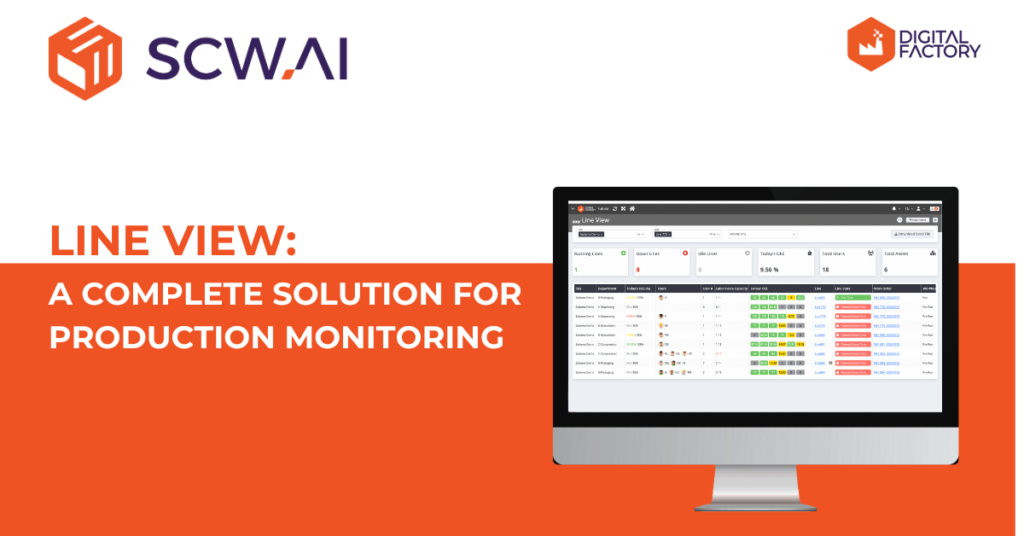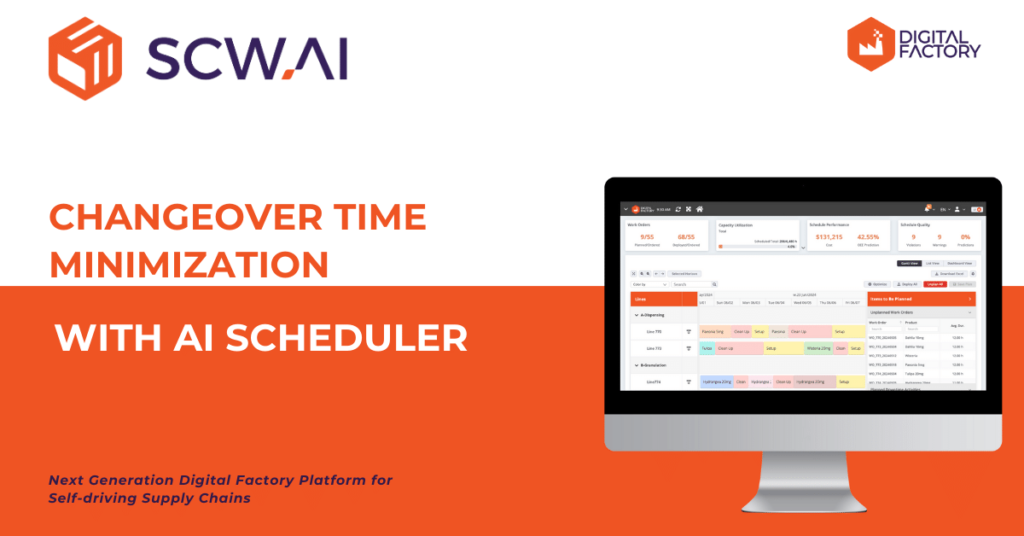Ensuring realistic and effective schedules is paramount for manufacturers to secure long-term profits. Deviations from schedules can lead to overproduction, underproduction, OTIF penalties, and diminished customer satisfaction as work orders may not be completed on time.
To assess the efficiency of scheduling, manufacturers often utilize schedule adherence as a Key Performance Indicator (KPI). This metric measures the percentage of work orders completed within the designated time frame, providing comprehensive data on the effectiveness of the scheduling process. However, real-time monitoring of this metric poses a challenge, limiting agile decision-making capabilities for manufacturers.
SCW.AI’s Schedule Adherence report addresses this challenge, allowing executives to monitor production plan success in real time. This enables managers to identify chronic bottlenecks in the scheduling process and shop floor activities. In this article, we will delve into the key metrics featured in our Schedule Adherence report and explore three strategic approaches that companies can adopt to harness its insights for optimizing factory efficiency.
An Introduction to Schedule Adherence Report

Schedule Adherence report is crafted to empower managers with real-time insights into the successful execution of schedules. To do so we prioritize schedule adherence as a key performance indicator (KPI), supplemented by additional metrics including Schedule Compliance and Schedule Attainment.
This report allows managers to conduct a detailed analysis by comparing scheduled and actual times for changeover durations and run-time on a per work order basis. This detailed analysis can shed light on:
- Strategies to enhance overall equipment effectiveness (OEE).
- Identification of machine and equipment conditions that necessitate maintenance.
- Uncovering scheduling inefficiencies to streamline operational processes and bolster efficiency.
Explore 10+ Key Metrics at Your Fingertips with the Schedule Adherence Report

SCW.AI’s Schedule Adherence report provides real-time data regarding the following 12 metrics:
1. Schedule Adherence
Schedule adherence is defined as the degree of loyalty to the production plan. In the manufacturing context, the schedule adherence formula entails dividing the number of started work orders planned for a specific time interval by the total number of work orders scheduled for that time interval, multiplied by 100. Schedule adherence takes values over 0, where 100 represents perfect adherence to the schedule. Generally, a schedule adherence score between 90 and 100 is targeted by manufacturers.
2. Schedule Compliance
To gauge the effectiveness of scheduling, adherence is not the sole available KPI. Schedule Compliance measures the average percentage of actual production time aligning with the planned production time for all work orders. For example, if you have a work order with a planned run time of ten hours scheduled between 1 p.m. to 11 p.m., and you start the work order at 2 p.m. and complete it at 12 p.m., your Schedule Compliance for this particular work order would be 90%. Schedule Compliance metric offers insights about potential OTIF scores. Higher deviations from 100% schedule compliance are associated with OTIF penalties and customer dissatisfaction.
3. Schedule Attainment
Frequently, work orders from previous scheduling periods impact the current scheduling period. Manufacturers often prioritize work orders from the previous period, which can reduce the schedule adherence metric of the factory, even if it has had a productive week. To measure this, the report features the Schedule Attainment KPI, calculated by dividing all work orders produced in a given scheduling period—whether they were planned for this period or not—by the number of planned work orders. Therefore, Schedule Attainment is often a greater value than Schedule Adherence. If the difference between these two KPIs is consistently high, it might indicate scheduling inefficiencies rather than shop floor performance ineffectiveness.
Other Metrics include:

- 4. Work Order On-Time Completion Rate: Demonstrates the percentage of work orders which are completed on-time (before its scheduled end date).
- 5. Number of Overdue Work Orders: Displays the count of work orders that remain incomplete beyond their due date.
- 6. Number of Started Work Orders (Planned): Shows the number of work orders started for the given scheduling period.
- 7. Number of Started Work Orders (Unplanned): Illustrates the number of work orders started but initially planned for a different period.
- 8. Number of Behind Schedule Work Orders: Demonstrates the number of work orders that will be completed later than what is scheduled based on the current production speed.
- 9. Number of Planned and not Started Work Orders: Illustrates the number of work orders that remain untouched even if they are scheduled for this specific period.
- 10. Planned Vs Actual Pre-Run Duration: Shows the difference between planned and actual pre-run duration (i.e., setting up the machine).
- 11. Planned Vs Actual Run Time Duration: Displays the variance between planned and actual run time duration.
- 12. Planned Vs Actual Post-Run Duration: Demonstrates the difference between scheduled and actual post-run duration (i.e., cleaning the line). Notice that, combination of post-run and pre-run activities make changeover time.
3 Ways to Utilize Schedule Adherence Report to Improve Efficiency

SCW.AI’s Schedule Adherence report is valuable for agile decision-making. For example, by examining the metric of the number of behind-schedule work orders alone, an executive can promptly make overtime decisions to meet deadlines. However, the true benefit of the Schedule Adherence report lies in its ability to reveal chronic bottlenecks in the production process and offer insights into their root causes, enabling managers to take corrective actions. Here are the top three use cases:
1. Detect Unplanned Downtime and Performance Losses
If the actual run time period consistently exceeds the planned run time duration, manufacturers should be wary of the following three root causes or their combination.
1.1 Equipment Ineffectiveness
You might be experiencing unplanned downtime due to equipment malfunctions, causing longer batch times. Another possibility is that the production speed might not be reaching your target due to the degradation of machine performance. To address these issues, AI can be an effective tool for manufacturers. For instance, you can assess machine degradation through visual inspections driven by digital twins or deploy machine learning models that predict equipment breakdown before it occurs.


1.2 Micro-Stops
Micro-stops are momentary interruptions in production, typically lasting less than 2 minutes. Although individually brief, chronic bottlenecks triggering micro-stops can accumulate, reaching up to one-third of the planned run time in some cases. Identifying their root cause is crucial, whether it is an external material disrupting the production line, setup errors, or other factors like electricity leakage or voltage fluctuations causing intermittent machine stoppages.
Addressing the root cause of micro-stops can be challenging and requires digital production tracking through Industry 4.0 technologies to enhance shop floor visibility. IoT tools and real-time location systems (RTLS) can be particularly beneficial in this regard, since they provide information on:
- Laborers,
- Equipment vibration, current, heat etc.
- Environmental factors such as heat, humidity etc. and more.
1.3 Labor Performance Issues
According to the National Association of Manufacturers’ (NAM) report, the foremost challenge for manufacturers in 2023 was the recruitment and retention of high-quality workers in their companies. In such a scenario, discrepancies between actual and intended production times may be attributed to labor performance issues. To address this challenge, companies should employ labor tracking tools to monitor workers and identify training needs in a data-driven manner.
2. Evaluate and Enhance Changeover Efficiency
As demonstrated by our OEE benchmarking analysis in the pharmaceutical industry, changeovers in some sectors can consume as much as one-third of staffed time, indicating a substantial availability loss. The Schedule Adherence Report can serve as a valuable tool for identifying inefficiencies in changeover processes. If the actual durations of pre-run and post-run activities consistently exceed the planned periods, it suggests a need for improvement in changeover practices.
AI-driven schedules (APS software) can play a crucial role in minimizing changeover time by organizing work orders that necessitate minor changeovers in succession, thereby reducing the frequency of major changeovers.
3. Assess Your Scheduling Capabilities
It is possible that the shop floor is operating effectively, but there is room for improvement in scheduling performance. The Schedule Adherence report can offer insights into this for the following scenarios:
- 100%+ Schedule Adherence: Indicates that your planned pre-run, run and post-run durations are longer than actuals. If this happens frequently, it implies that the scheduling team is underestimating the productivity of the factory.
- Consistent Disparity Between Schedule Adherence and Schedule Attainment: If your Schedule Attainment consistently surpasses Schedule Adherence, it implies that the shop floor is productive, as the factory can finish a significant number of work orders. However, since the produced work orders belong to another scheduling period, the adherence rate becomes low, indicating ineffective scheduling processes.
- Low Schedule Adherence, Compliance and Attainment Metrics: If your scheduling metrics consistently remain low, it might suggest that you may be taking on too many work orders beyond your capacity. In such a case, there is a likelihood of receiving OTIF penalties and unsatisfied customers, which might lead to a loss of collaboration due to unrealistic production planning.
How Can SCW.AI Assist You in the Quest for Efficiency
SCW.AI’s Digital Factory Platform offers a comprehensive solution to address the visibility, productivity, and agility needs of manufacturers. We support your scheduling team with AI-driven schedulers and provide reports on scheduling adherence, as outlined in this article. Additionally, our platform ensures 24/7 factory visibility through:
- OEE Tracker: Provides comprehensive information regarding your efficiency via reports like OEE Waterfall, Changeover Analysis, Maintenance Performance Report, Micro-Stop Analysis, Daily Production Performance Report and more.
- Labor Tracker: Ensures effective labor allocation via Labor Skill Matrices and RTLS.
- IoT Hub: Collect data in real-time regarding processes, equipment, laborers and environment.
- AI Hub: The AI Hub serves as a technological nucleus, leveraging cutting-edge algorithms specifically designed for scheduler optimization, predictive maintenance, and anomaly detection tailored to be utilized by manufacturers.
To learn more regarding SCW.AI’s comprehensive solutions tailored to the manufacturing industry you can book a demo today!


